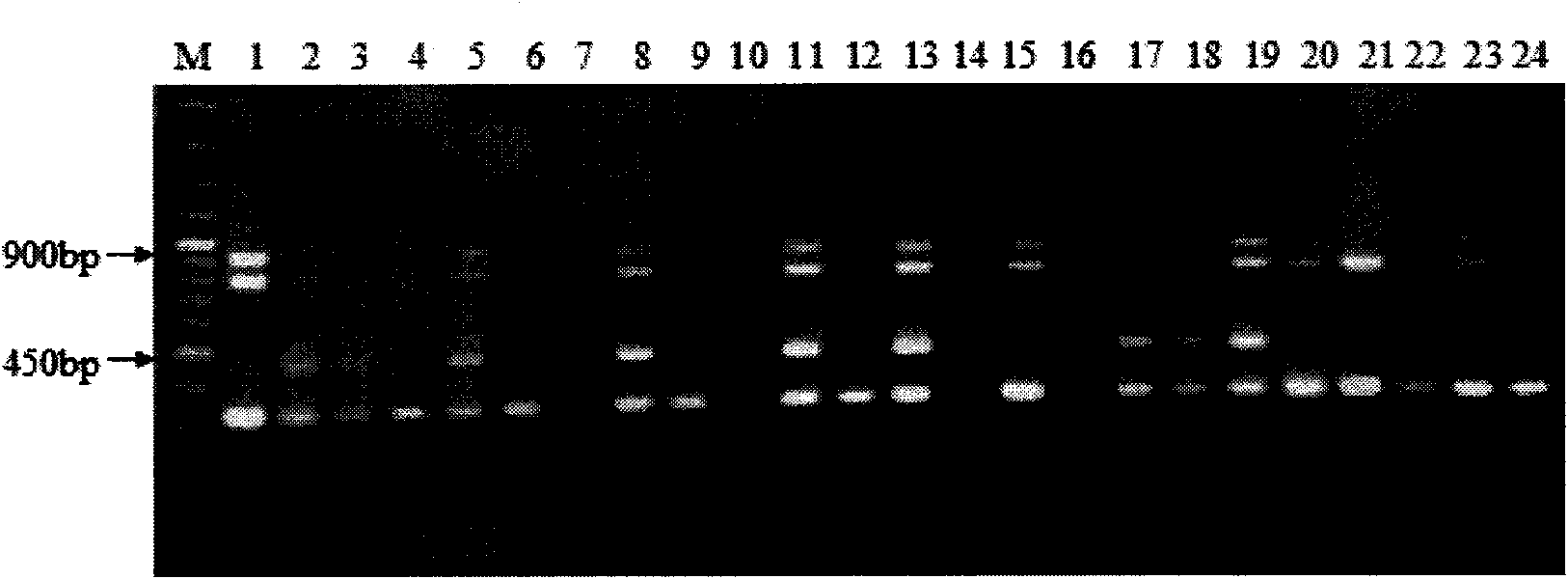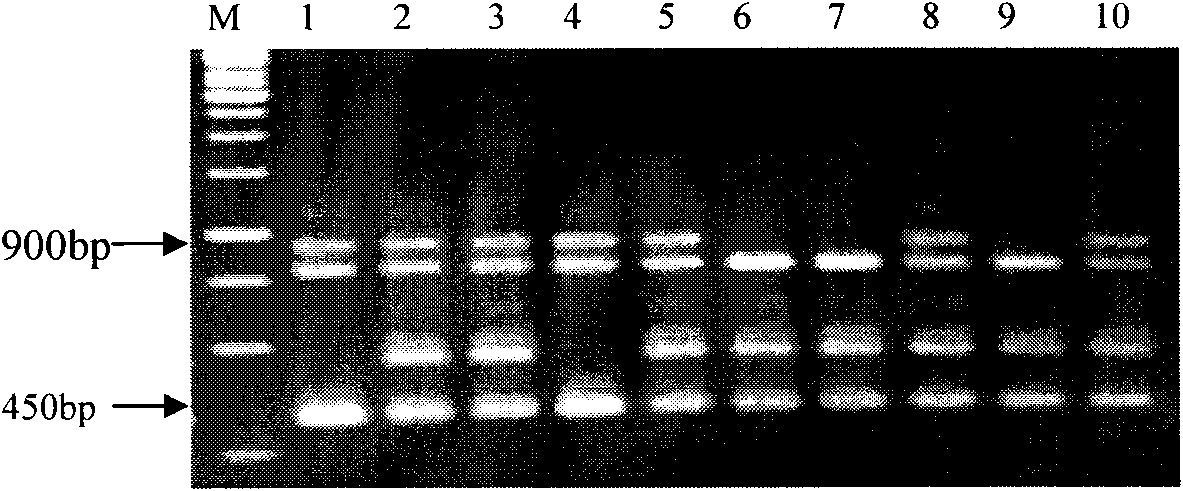Molecular marker auxiliary selection method for TYLCV breeding
A yellow leaf curl virus, molecular marker-assisted technology, applied in biochemical equipment and methods, microbial determination/inspection, etc. The effect of improved screening efficiency, high efficiency and cost, easy operation
- Summary
- Abstract
- Description
- Claims
- Application Information
AI Technical Summary
Problems solved by technology
Method used
Image
Examples
Embodiment 1
[0026] Embodiment 1: (Utilize molecular marker assisted selection method to the resistance detection 1 of hybrid progeny material)
[0027] The specific implementation steps in this example are:
[0028] 1. Parent material and hybridization method:
[0029] ①Parent material:
[0030] Excellent tomato line T01-198: bred and preserved by Vegetable Research Institute of Zhejiang Academy of Agricultural Sciences. The Netherlands introduced a hybrid generation 'Tomato Serrei';
[0031] 07-026: Contains resistance gene Ty-3 against tomato yellow leaf curl virus disease, provided by Asian Vegetable Research and Development Center (AVRDC);
[0032] 07-027: Contains resistance gene Ty-2 against tomato yellow leaf curl virus disease, provided by Asian Vegetable Research and Development Center (AVRDC);
[0033] ② Hybridization method:
[0034] With T07-026 as the female parent and T01-198 as the male parent, it was awarded F 1 Hybrid combination 07-026×T01-198; then use T01-198 as ...
Embodiment 2
[0046] Embodiment 2: (Utilize molecular marker assisted selection method to the resistance detection 2 of hybrid progeny material)
[0047] The specific implementation steps in this example are:
[0048] 1. Parent material and hybridization method:
[0049] ①Parent material:
[0050] 9179 is a stable strain selected from highly segregated offspring after 8 generations of strains after crossing the first-generation hybrid variety 9502 introduced from Europe with high resistance to leaf mold and 9132 introduced by the Asian Vegetable Research and Development Center. Infinity, pink, large fruit, resistant to leaf mold, susceptible to tomato yellow leaf curl virus;
[0051] 07-026 and 07-027 materials are the same as in Example 1;
[0052] ② Hybridization method:
[0053] With 9179 as the female parent and 07-027 as the male parent, it was awarded F 1 The hybrid combination 9179×07-027; the F with 07-026 as the male parent 1 Hybridization was carried out to obtain the three-...
Embodiment 3
[0057] Embodiment 3: (application of artificial seedling stage inoculation identification method to the verification of molecular marker-assisted selection of resistant materials)
[0058] The resistance homozygous and heterozygous band types of screening markers were used to select resistant plants. During the breeding process of tomato resistance to yellow leaf curl virus disease, double PCR technology was used to simultaneously detect Ty-2 and Ty-3 genes, and to screen Material containing resistance gene 07-026×T01-198BC 1 -6, 07-026×T01-198BC 1 -86, 07-026×T01-198BC 1 -112, (2698BC 1 -6×07-027)F 2 -53, (2698BC 1 -6×07-027)F 2 -72, ((9179×07-027)×07-026)F 2 -88, ((9179×07-027)×07-026)F 2 -105, etc., and then further applied the artificial seedling inoculation identification method to verify the molecular marker-assisted selection resistant plants (Table 1).
[0059] Table 1 The incidence of the resistant material TYLCV whitefly after inoculation
[0060] res...
PUM
 Login to View More
Login to View More Abstract
Description
Claims
Application Information
 Login to View More
Login to View More - R&D
- Intellectual Property
- Life Sciences
- Materials
- Tech Scout
- Unparalleled Data Quality
- Higher Quality Content
- 60% Fewer Hallucinations
Browse by: Latest US Patents, China's latest patents, Technical Efficacy Thesaurus, Application Domain, Technology Topic, Popular Technical Reports.
© 2025 PatSnap. All rights reserved.Legal|Privacy policy|Modern Slavery Act Transparency Statement|Sitemap|About US| Contact US: help@patsnap.com


